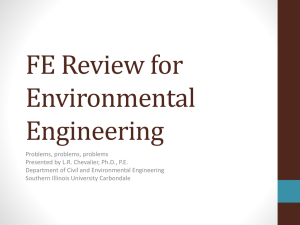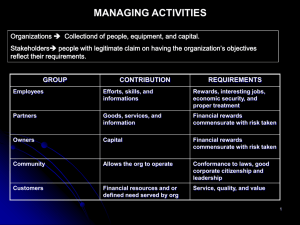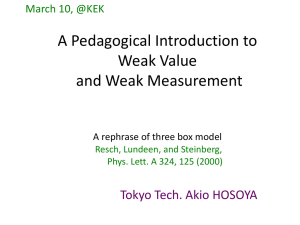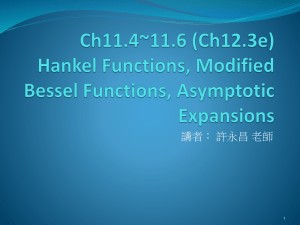mrcc - IISER Pune
advertisement
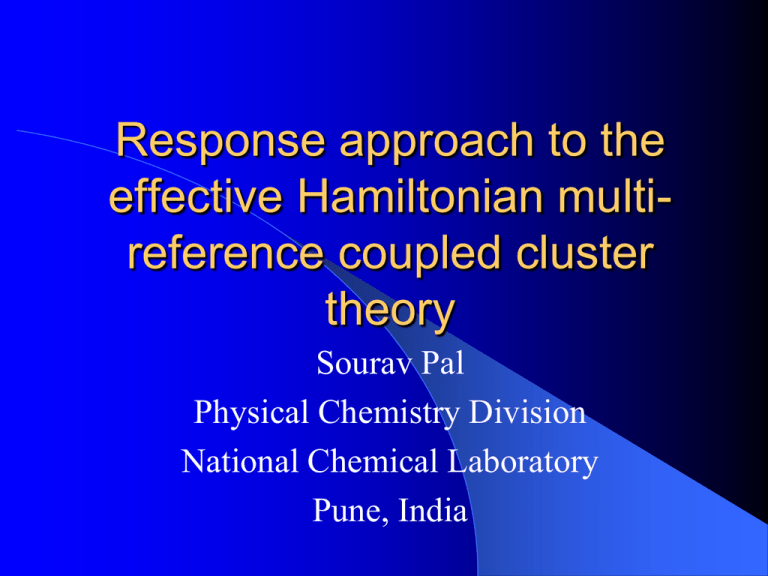
Response approach to the
effective Hamiltonian multireference coupled cluster
theory
Sourav Pal
Physical Chemistry Division
National Chemical Laboratory
Pune, India
Model Theoretical Chemistry
Unified model to describe ground and
excited states of different symmetry and of
general applicability
Efficient summing up of dynamical
correlation, which is important around
equilibrium.
In near-degenerate cases, a few equally
important determinants contribute. Theory must
include this non-dynamical electron correlation
correctly
Balanced treatment of electron correlation in
different states of interest
Correct scaling of energies and properties
Correct separation limit results
Electron Correlation
Instantaneous repulsion between electrons,
which can not be accounted by spherical
averaging
In the actual interacting problem, electrons tend
to avoid each other, but in Hartree-Fock theory
electrons with only parallel spins avoid each other
Correlation of electrons with anti-parallel spins
Electron
correlation
methods
include
configuration interaction, perturbation theory,
various coupled pair theories , coupled cluster
theory etc.
Perturbation theory is based on perturbation
expansion of the energy and wave function in
terms of the residue perturbation operator, which
is the difference of actual two particle interaction
and the its spherically averaged part.
Configuration Interaction
Method
0 = c 0 0 + i,a c ia ia + ij a b c ij, abij ab
Linear combination of determinants
generated by ordered excitation of
electrons from occupied spin orbitals to
the virtual orbitals. The coefficients are
obtained by a variational principle.
Matrix linear eigen-value problem
HC =CE
H is a matrix of the Hamiltonian over the
determinants and C is the matrix of the
coefficients and E is diagonal matrix containing
the energies of the states as diagonal elements.
Approximate CI is size-inextensive and does not
separate correctly into its fragments.
Coupled cluster method
Coupled cluster is a well established method.
Unlike CI it is nonlinear in structure. Use of
exponential excitation operator instead of
linear operator is the genesis of the coupled
cluster method.
exp (T) HF
T : hole particle excitations on HF , it can
be decomposed as
T = T1 + T2 + T3 + ……Tn
T1
= i,a tia {a+i } , T 2 = i j, ab(1/ 2!)2 t ij ab { a+ b+ j i }
i,j,k,
etc are occupied spin orbitals and a,b,c,
are the
unoccupied orbitals.
HF > as hole-particle vacuum, a+,b+
are the particle creation operators and i,j, are
the hole creation operators.
With
ccsd
J.
exp (T1 + T2 ) HF
Cizek JCP 45, 4256 (1966); Bartlett and co-workers
Standard Coupled-cluster equations are obtained
by method of projecting the Schrodinger’ s
equation to the Hartree-Fock and excited
determinants
H exp (T) HF = Eo exp (T) HF
Pre-multiplying by exp ( -T) and projecting to the
Hartree-Fock and excited determinants,
HFexp (-T) H exp (T) HF = Eo
*exp (-T) H exp (T) HF = 0
* are excited state determinants
exp (-T) H exp (T) has Campbell Backer
Hausdorff multi-commutator expansion
exp (-T) H exp (T) = H + [ H, T] + ½ ! [[ H, T], T] +
Diagrammatically, this leads to a fully connected
operator , where the first T is connected to H and
every T is connected to the piece of connected
H,T. However, since T can not connect to itself (
because of the special structure of T’s defined by
the same vacuum ), every T must be connected
General non-linear equation, quartic for
CCSD
A + BT + CT T + DT T T + E T T T T =0
Important consequences:
· Size extensive theory ( proper scaling)
· CBH expansion formally truncates
Multi-Reference coupled
cluster theories
Fock space coupled cluster method
Valence universal cluster operator to
correlate systems with different number of
valence electrons
Single vacuum
Advantages::
Energy difference calculations , IP,EA,and EE
Disadvantages::
Potential energy surfaces difficult to calculate due to
intruder State problem
Hilbert space coupled cluster
method
As many cluster operators as the number of states
with a given fixed number of valence electrons
Advantages::
Potential energy surfaces are easy to get
Disadvantages::
Difference energies are difficult to get
MRCC effective Hamiltonian
approach
Define quasi degenerate model space P
Po =
i Ci | >
Transform Hamiltonian by to obtain an effective
Hamiltonian such that it has same eigen values as
the real Hamiltonian
Po Heff Po = Po H Po
( Heff)ij C j = E C I
Obtain energies of all interacting states in model
space by diagonalizing the effective Hamiltonian
Over the small model space P.
Simple formulation of effective Hamiltonian
theory
H exp (T ) i Ci |i > = E exp (T ) i Ci | i >
(Heff) ji = < j| exp (-T) H exp (T) | i >
Due to different structure of T’s, special effort
need be made to prove linked cluster
expansion of the operator.
More efficient formulation of solution of
effective Hamiltonian is due to Bloch, Des
Cloizeaux and Kubo
( Mukherjee, Lindgren, Kutzelnigg)
Effective Hamiltonian defined over the smaller
dimension
Eigen values of Heff are the exact energies of
the system
Multiple states at a time at a particular
geometry
Multi- reference coupled cluster thus is more
general and powerful electronic structure theory
To make the theory applicable to energy
derivatives like properties or gradients, Hessians
etc., it is important to develop linear response to
the MRCC theory
S. Pal, Phys. Rev A 39, 39, (1989); S. Pal, Int. J. Quantum Chem,
41, 443 (1992); D. Ajitha, N. Vaval and S.Pal, J Chem Phys 110,
8236 (1999); J. Chem Phys 114, 3380 (2001); K R Shamasundar
and S. Pal, J. Chem. Phys. 114, 1981 (2001); Int. J. Mol. Sci. 3,
710 (2002)
Hilbert space MRCC method
|> exp (T) | Ci
exp (T) |> < |
Wave operator for a system with fixed
number of electrons
Equations for T are obtained by Q
projection of Bloch Lindgren equation.
l ( ) |exp (-T) H exp (T) |= H eff
l ( ) | exp (-T ) exp (T) |
H eff exp(-T) H exp (T) |
Linear Response of HSMRCC theory
Heff C (1) + Heff (1) C = C E (1) + C(1) E
[ Heff (1) ] = exp (-T) { H(1) + [H, T (1) ] }
exp (T) |>
Compact expression
[Heff (1) ] Y F (1)
Q V(1)
l (exp (-T){ H(1) + [H, T(1) ]}
exp (T)
[ Heff lexp (-T) (T(1) - T(1))
exp (T) | > +H eff(1) l) exp (-T)
exp(T) = 1,….M
Z- Vector method for
HSMRCC theory
In a compact form the response equation may be
written as,
A T (1) = B
A : Perturbation -independent matrix
B : Perturbation-dependent column vector
Eliminate perturbation-dependent T(1) in energy
expression
Z-vector solved from a perturbation independent
linear equation
For a single state I in HSMRCC case
E I (1) = C' i [Heff (1) ] Ci
Simplified expression
E I (1) = Y (I) * T (1) + X(I) * F(1) + Q(I)* V(1)
Define Z-vector Z(I)through Matrix
equation
Y (I) = Z (I) A
E I (1) expressed in terms of z-vector
E I (1) = Z ( I) * B + X (I) F (1) + Q (I) * V (1)
Z - vector although perturbation
independent, still depends on state of
interest
No - Z- vector for all roots at the same time
Fock Space Multi-reference
Coupled-Cluster Approach
( Mukherjee and Pal, Adv. Quant. Chem. 20, 291
,1989)
N-electron RHF chosen as a vacuum, with respect
to which holes and particles are defined.
Subdivision of holes and particles into active and
inactive space, depending on model space
General model space with m-particles and n-holes
(0) (m,n) = iC i I (m,n)
J (Q )
[n]
[n]
[ n ]
C A C A H eff
n
M
[i]
(T [ i ] , H eff[ i ] , [ i ] )
i0
E A ( C A C A 1)
[n]
[n]
n
k i
M
T
[k ]
[i]
0
Variants of Multi-reference CC
Effective Hamiltonian theory: Effective Hamiltonian over
the model space of principal determinants constructed and
energies obtained as eigen values of the effective
Hamiltonian
Valence-universal or Fock space: Suitable for difference
energies ( Mukherjee, Kutzelnigg, Lindgren, Kaldor and
others)
Common vacuum concept; Wave-operator consists of
hole-particle excitation and de=excitation of active holes
and particles
o State-universal or Hilbert space: Suitable for the potential
energy surface. Each determinant acts as a vacuum (
Jeziorski and Monkhorst, Jeziorski and Paldus, Balkova
and Bartlett)
Structure of FSMRCC response
equations
J (Q )
[n]
[n]
C A C A H
[ n ]
eff
n
M
[i]
(T [ i ] , H eff[ i ] , [ i ] )
i0
E A ( C A C A 1)
[n]
[n]
M
[i]
(T , H , )
[i]
[i]
eff
[i]
|
[i]
|
[i ]
[i]
|
[i]
l
[i]
l
,l
[i]
,
| H H
| | H H
[i ]
[i ]
eff
eff
[i]
[i ]
|
[i]
|
[i ]
Structure of FSMRCC response
equations
The stationary equations are obtained by
making the Lagrange functional stationary
with respect to the T amplitudes,
amplitudes and effective Hamiltonian
elements.
n
i C A C A
n
[n]
[n]
k i
n
k i
M
[k ]
H eff
M
T
[i]
0
[k ]
[i]
0
Structure of FSMRCC response
equations



